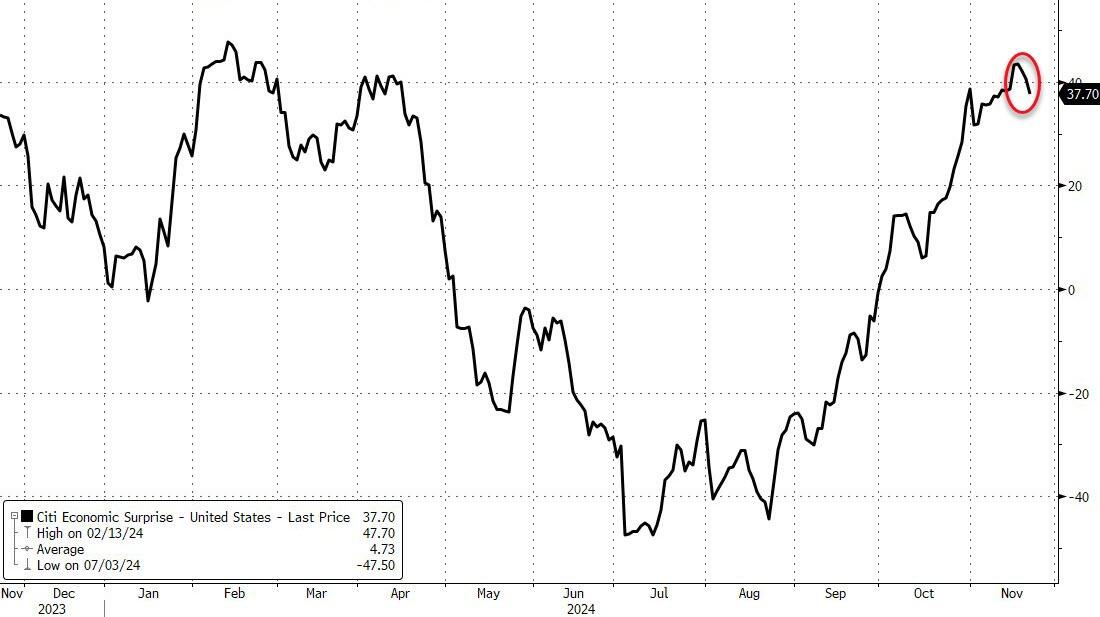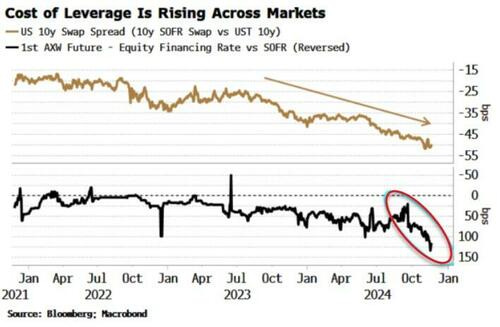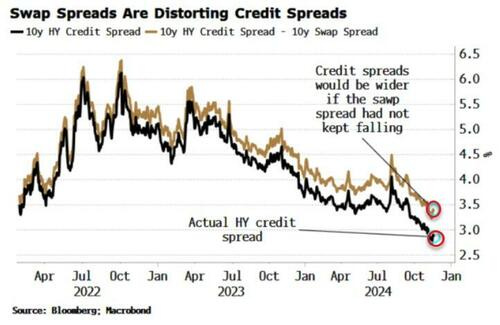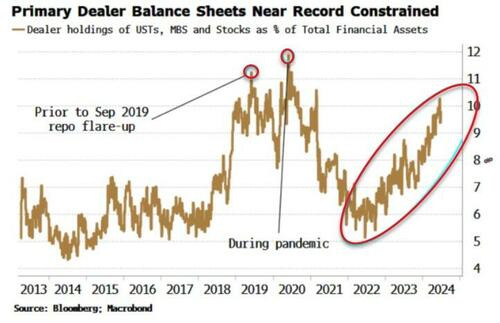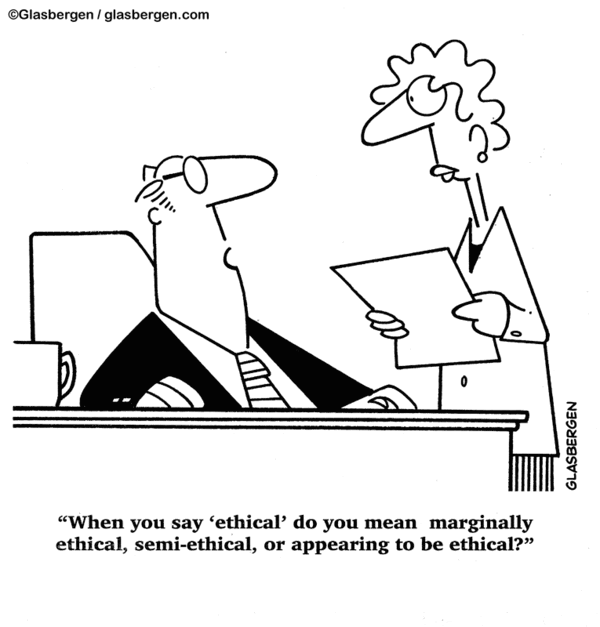while WE slept: (EZ) Bonds soar in reaction to dire EZ PMIs, USTs catch bid;
Good morning …
MarketWatch: U.S. Treasury yields drop after weak eurozone activity data
… so the risk off reflex value of USTs remains to be NOT DEAD YET …
Bloomberg: Euro-Zone Private Sector Unexpectedly Slips Into Contraction
… good to know and making matters MORE / LESS clear, well, have a look at the data received yesterday here in the USofA and kindly choose your own ending …
ZH: Continuing Jobless Claims Hit 3-Year-Highs As Initial Claims Tumble To 7-Month-Lows
… and while one weekly point of data does NOT a narrative shift make, it certainly helped set the tone and, whatever you think you think, by days end there were a couple things that were made clear … Bad macro / econ news not translating to MOAR cowbell …
ZH: Mega-Caps Mullered As Bitcoin, Bullion, & 'Big Shorts' Burst Higher
Of course, as goes NVDA, so goes the market, and after last night's beat (but disappointing revenue forecast), the giantest of giant tech companies swung around like a penny stock, adding and subtracting $100s of billions in market cap in an instant …
… On the macro side, it was 'bad news': Philly Fed fell hard in November (from +10.3 to -5.5 vs +8.0 exp), Continuing Jobless claims topped 1.9mm Americans for the first time in three years (initial claims dropped), and the Leading Index dropped 0.4% (more than expected). Initial claims and existing home sales were positive to offset some of the negative but overall, the US Macro Surprise index actually rolled over...
… Rate-cut expectations continued to slide with less than three full 25bp cuts now priced-in by the end of 2025...
… go figure.
With miles to go before we sleep tonight AND as equity futures tracking lower as Global Wall (and rates)still tracking higher on the week, again I’ll say … choose your own ending.
AND as you do, I’ll quit while I’m behind and hope to offer something more over the weekend. Meanwhile … here is a snapshot OF USTs as of 640a:
… and for some MORE of the news you might be able to use…
IGMs Press Picks: November 22 nd 2024
NEWSQUAWK: Dismal EZ PMIs hit risk sentiment, with Bonds bid and EUR at lows … Bonds soar in reaction to dire EZ PMIs which have boosted the odds of a 50bps ECB cut … USTs are firmer moving in tandem with the above thus far. Rose to a 109-25 peak on the morning’s flash PMIs from the bloc and France/Germany beforehand. For the session ahead, USTs await their own PMIs with the Fed docket very light today until Bowman after hours.
PiQ Overnight News Roundup: Nov 22, 2024
Reuters Morning Bid: Euro/dollar stares at parity, Bitcoin eyes $100k
Finviz (for everything else I might have overlooked …)
Moving from some of the news to some of THE VIEWS you might be able to use… here’s SOME of what Global Wall St is sayin’ …
… wait, what? rates matter, you say …
BARCAP: October existing home sales increase as weaker mortgage rates feed into the market
Existing home sales increased 3.4% m/m in October, to 3.96mn, after declining in the prior two months. Reduced mortgage rates in September that flowed into the resale market aided in the higher sales seen today, but increased rates since should limit sustained increases.
… From rates right back to … stonks we go …
BARCAP: Equity Market Review: Trump guessing game
The guessing game about how Trumponomics plays out will likely keep price action jittery into inauguration day. Ukraine headlines may get worse before any attempt to broker a ceasefire, but reconstruction may well start in 2025. Away from the Trump noise, we still see AI investment theme intact.
… a large German bank econ dept weighing on (again) on the election …
DB: Trump II: Growth too fast, inflation too furious for Fed cuts
The Republican sweep in the 2024 election promises to bring transformative changes to the economic landscape across policies related to regulation, trade, immigration and tax and spending. While the breadth of the electoral victory provides a pathway to implement the agenda, relatively tight margins in Congress, and the Administration's possible sensitivities to market reactions, could limit the most extreme policies.
Stronger momentum heading into 2025 combined with modest tax cuts, a deregulation push, and more supportive financial conditions should produce faster growth next year, which we now see at 2.5% (Q4/Q4) versus 2.2% previously. Beyond next year, adverse effects from higher tariffs and retaliatory trade restrictions abroad, as well as more restrictive monetary policy, reduce our growth estimates modestly. With productivity growth staying elevated, we see a case for potential growth in the mid-2% range.
Downside risks to the labor market have diminished but have not fully vanished. The labor market should show clearer signs of stabilizing in the near term and ultimately retighten modestly next year. We now see the unemployment rate falling a few tenths to 3.9% in 2025. Importantly, our labor market forecast does not account for sweeping changes to immigration policy.
Recent data show progress on inflation has slowed. This policy mix will reinforce these signals. We now anticipate that core PCE inflation will stall at or above 2.5% through 2026, in contrast to our prior forecast which anticipated inflation could dip to 2% by that time. The primary driver of this upward revision is a significant increase in tariffs.
These revisions are hawkish for the Fed and reinforce our long-held view that neutral is higher. Our baseline sees a 25bp cut in December, though that is a close call. Thereafter, we expect an extended pause which keeps the fed funds rate above 4% into 2026 before eventually guiding the policy rate back to nominal neutral (3.75-4%). The Fed could drop its easing bias if inflation proves stickier prior to the tariffs, the labor market shows signs of reaccelerating, and especially if inflation expectations rise.
Our baseline forecast is subject to more uncertainty than normal, with the exact timing, sequencing and details around policy changes unknown. New information is likely to emerge that will require revisions to our policy assumptions. This environment will require that forecasters remain humble and nimble. We therefore provide a thorough discussion of risk scenarios, including a quantification of a more severe trade war.
… and as risks heat UP, well, Global Walls got a radar screened for you …
UBS: Global risk radar: Global Risk Radar: Middle East conflict remains at risk of escalation
The risk of an escalation of the war in the Middle East remains high. President-elect Donald Trump’s policies toward the Middle East, and actors positioning ahead of Trump’s inauguration, could be trigger points in the weeks ahead.
We do not expect the conflict to expand into an all-out war between Israel and Iran, including their respective allies. But the likelihood for such a risk case remains high and has increased, in our view, following Trump’s election, including the possibility of direct US involvement and prolonged disruptions to energy supplies.
Given the potential market impact of an escalation, we highlight the importance of diversified portfolios to limit the exposure to individual risks while staying invested to benefit from the overall supportive global macro backdrop. Oil and gold can help hedge geopolitical risks.
… check, please, you say? don’t go yet …
UBS: Political checks and balances
Former US Congressperson Gaetz withdrew from the nomination to be US attorney general. This is not a post with much direct importance to investors (beyond a general belief in the rule of law). However, it might be read as the Senate challenging someone regarded as an unorthodox choice. Investors often prefer orthodoxy, especially for roles at (for instance) the Federal Reserve …
… The dubious nature of consumer sentiment data will be displayed with US Michigan sentiment figures. Other surveys suggest a decline in current economic conditions for Democrats, and transports of delight for the Republicans’ economic environment. It is possible this is nothing to do with the economy at all …
… NOT what you meant? my bad …
… wait, what? rates matter, you say …
Wells Fargo: Existing Home Sales Improve in October
The Rise Reflects the Temporary Late Summer Dip in Mortgage RatesSummary
Upturn in Sales Likely to be FleetingExisting home sales strengthened 3.4% during October, ending a two-month streak of declines. The improvement mostly reflects the decline in mortgage rates that occurred in August and September in anticipation for a reduction in the federal funds rate from the Federal Reserve. The upturn is likely to be short-lived given mortgage rates have legged higher in recent weeks and the bounce in mortgage purchase applications experienced in the late summer has reversed.
As we noted in our Annual Economic outlook published this morning, the housing market will likely encounter some near-term headwinds as buyers grapple with higher-than expected financing costs. What's more, a smaller step down in rates next year means the mortgage rate lock-in effect will persist and keep new inventory relatively scarce.
… and dr bond vigilante weighs in … on stocks and the rally …
Yardeni: Stock Market Rally Broadening As Economy Chugs Along
… The upturn in US Treasury note and bond yields since the Fed started cutting the federal funds rate (FFR) on September 18 reflect the rebound in the Citigroup Economic Surprise Index (chart). In our opinion, this suggests that the neutral FFR is probably closer to the 5.25%-5.50% range (just before September 18) than the current 4.50%-4.75%. If so, then economic growth is getting an extra boost from easier Fed policy. Fed officials disagree with us. They think that the FFR remains restrictive and needs to be lowered closer to 2.90% though gradually rather than in a rush.
… And from Global Wall Street inbox TO the WWW …
Here’s is technician weighing in on Mother Nature (with a look at 2s vs FF which caught my eyes, not, in fact THE chart of the week) …
McClellan Financial: Sunspots: A Driver of Unemployment - Chart In Focus
… The big rise in unemployment during 2007-09 is a little bit harder to explain in relation to the sunspot cycle. Former Fed Chairman Alan Greenspan managed interest rates poorly in the early 2000s, leading to the real estate bubble which peaked in 2005-06, and which led to the Great Financial Crisis (GFC) of 2008 when banks and other holders of mortgage debt had a lot of problems. It did not help that the Fed was working extra hard in 2007 to make up for Greenspan's mistaken period of low rates.
The economy would be better served if the Fed would just listen to the 2-year T-Note yield, and set its interest rate policy based on that message. When the Fed officials think they know better, that is when we get problems of either overstimulation or excessive restriction. What the Fed arguably did with those actions in the 2000s was to pull forward the effect of the sunspot cycle by a couple of years. Since then, the unemployment rate has gotten back in sync again, except for the large spike during Covid.
… finally from the terminal via ZH, a question for those in the rates space …
ZH: Is Massive Treasury Issuance Sowing The Seeds Of A Funding/Liquidity Crisis?
Huge Treasury borrowing is leading to funding pressures and distortions across stocks, bonds and credit.
Markets are starting to feel more acutely the effects of Leviathan’s insatiable appetite for borrowing. The onslaught of Treasury issuance is crowding out other borrowing and increasing the risk of a funding-driven correction in stocks, while also distorting the signal from credit spreads. Quantitative tightening is likely to be one casualty if stresses do not ease.
The consequence of running annual $1.5 trillion to $2 trillion fiscal deficits is becoming clear. The weight of government issuance is congesting dealer balance sheets and leading to an increased cost of leverage. Two of the most prominent places that is showing up are in swap spreads and equity-financing costs.
Both of those reflect the market’s embedded cost for obtaining exposure to bonds or stocks without having to put up all the capital, i.e. leverage. Without it, it is highly unlikely assets would have risen to such high valuations.
That leaves them at risk of steeper falls should leverage be abruptly curtailed or withdrawn. The chart above shows the steady decline in swap spreads, reflecting increasingly constrained primary-dealer balance sheets. That is now starting to show up in other places, such as the cost of equity financing, i.e. the ability to get exposure to stocks through derivatives (futures, total return swaps, etc). As the bottom panel of the chart above shows, it has blown out in recent weeks.
So what exactly is going on? The swap spread is the difference between a swap rate and the bond yield of equivalent maturity. It’s falling as bond yields are rising more than swap rates. There are several causes but the primary one is that the balance sheets of primary dealers are becoming increasingly congested. The inventory of Treasuries that dealers hold is near highs, both in absolute terms and as a percentage of total USTs outstanding.
Dealers are therefore less able to take the other side of declining swap spreads, and they continue to fall in the face of a deluge of government issuance. It then becomes more costly to hold Treasuries and remove short-term funding risks (as levered players do).
There are other impacts.
Falling swap spreads are distorting the credit risk that is inferred from credit spreads. IG and HY spreads have been tightening, but this does not necessarily reflect an improvement in credit conditions. Indexes of credit default swaps, which are a purer measure of credit risk, have not tightened to the same extent as credit spreads.
In effect, more negative swap spreads entail a higher cost of positioning for credit spreads to widen. (The trade involves shorting corporate bonds, buying Treasuries against them to hedge the duration risk, and receiving the swap spread — which has been diminishing — to eliminate short-term funding risks.) Adjusting credit spreads for the swap spread shows that the decline in the latter has increasingly depressed credit spreads.
Equities are also in Leviathan’s firing line. As Cameron Crise pointed out on Tuesday, equity financing has blown out recently (see first chart), to levels potentially last seen in the GFC.
Primary dealers don’t only facilitate the smooth intermediation of Treasuries, they engage in many other risk-transferring and risk-creating activities too. One of those is supplying the seemingly unquenchable demand for long equity exposure.
One could of course buy stocks outright and use up chunks of one’s balance sheet to do so. But that’s passé in the world of high finance. Instead, buy an equity future or a total-return swap from a primary dealer and leverage your return.
That appears to be what has been happening. The net long in index futures (S&P + Nasdaq + Dow) of asset managers and leveraged funds has risen to new highs as a percentage of open interest. At the same time, “equity repo” on dealer balance sheets has also risen to series highs (or equivalently dealer net shorts in futures has risen to new highs).
As long as equities rise and vol is contained, the demands on dealer balance-sheets will intensify through the rising market-cap of equity collateral that needs to be financed, and through encouraging yet more leveraged-long exposure to stocks.
Overall, through the holdings of Treasuries, equities and MBS, dealer balance sheets are nearing a level of constraint last seen before the repo flare-up in September 2019 and during the pandemic.
Unless Elon Musk manages to “trim” $2 trillion from Federal outlays, or even close to it, as things stand the Treasury is unlikely to rein in its borrowing any time soon. That means the flood of issuance will persist and continue to eat up balance sheets of leverage providers.
It’s not clear where this leads but at the very least it’s a time to be on one’s guard. With animal spirits re-energized after Trump’s re-election, still-loose financial conditions and extant high levels of leverage along with unfettered risk-taking, the ingredients are there for an abrupt turnaround in risk assets. Such an outturn would be likely to prompt the Federal Reserve to hasten the end of QT.
Nonetheless, as long as excess liquidity remains strong and near-term recession risk remains low, the likelihood of a much deeper correction in risk assets is on the low side.
Finally, a word on earnings report in the week just passed …
oh, wait … not earnings related? My bad AND… THAT is all for now. Off to the day job…



